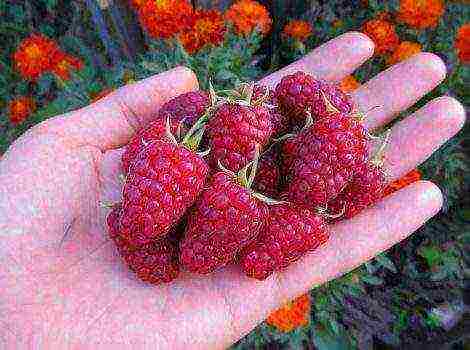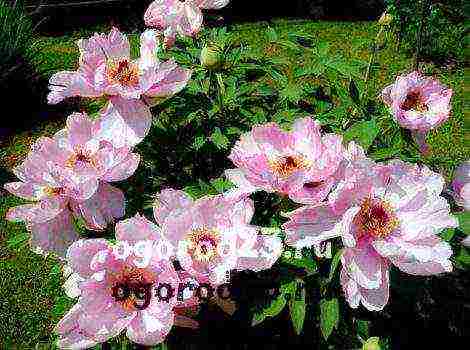Content
- 1 The choice of planting material
- 2 Selection of a place for growing hyacinths in the open field
- 3 Planting hyacinths
- 4 Planting dates for hyacinths for growing in the open field
- 5 Growing hyacinths outdoors and caring for them
- 6 Hyacinth care after flowering and harvesting bulbs
- 7 Storing hyacinth bulbs
- 8 Planting hyacinths
- 9 Care
- 10 Hyacinths in landscape design
- 11 Growing hyacinths outdoors
- 12 Hyacinth care in the garden
- 13 How to plant hyacinths in the spring in the garden
 Natives of the Mediterranean and Southeast Asia, hyacinths bloom in early spring, striking with the aroma spreading in the air and a riot of color from white and all shades of blue to yellow and even deep burgundy.
Natives of the Mediterranean and Southeast Asia, hyacinths bloom in early spring, striking with the aroma spreading in the air and a riot of color from white and all shades of blue to yellow and even deep burgundy.
South of the North Caucasus, fragrant flowers are found even in the wild. On the mountain slopes and in the valleys, you can see arrows with blue or pink buds making their way from under the snow. It is not difficult to grow hyacinths in open ground, subject to a mild winter and frost-free soil.
Appearing above the ground, the bright green glossy leaves of the plant gradually open up, and a cluster inflorescence with 20-30 buds begins to rise from the middle. The flowers of modern varieties of hyacinth are tubular, funnel-shaped or bell-shaped, can be ordinary and double, and always have an unusually rich aroma.
 How to plant hyacinth in the middle lane, where the soil invariably freezes, how to take care of the plant in order to get consistently lush flowering?
How to plant hyacinth in the middle lane, where the soil invariably freezes, how to take care of the plant in order to get consistently lush flowering?
The choice of planting material
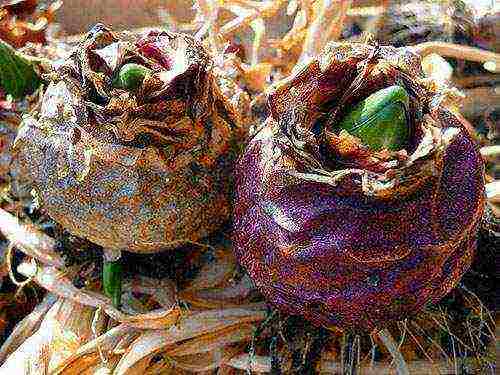 Hyacinths are typical bulbous plants. Perennial bulb of this type:
Hyacinths are typical bulbous plants. Perennial bulb of this type:
- fully formed by the age of 4–6;
- has a spherical shape with a prominent neck;
- consists of numerous scales, the inner ones are dense and fleshy, and the upper ones are thin and outwardly similar to parchment.
The growth of the bulb is due to the regeneration bud formed in the core, which consists of several primordia of leaves and the future peduncle. Adult bulbs 5–6 years old at the bottom under storage scales form the rudiments of daughter bulbs - children.
 Moreover, depending on the variety of hyacinth, its bulbs can have different sizes. As a rule, bulbs producing double flowers are smaller than usual.
Moreover, depending on the variety of hyacinth, its bulbs can have different sizes. As a rule, bulbs producing double flowers are smaller than usual.
- If hyacinths are to be grown in the open field, by the time of planting the bulb should be elastic, at least 4 cm in diameter and consist of several surface scales, 6-10 accumulation scales and a fully formed bud.
- On the outer surface of the planting material there should be no mechanical damage, traces of mold, diaper rash or lethargy.
- Looking at the bottom of a high-quality bulb, you can see two-millimeter root buds.
- The diameter of a high-quality bulb is one and a half times the size of the bottom.
Such planting material will not only successfully root and overwinter, but will also give abundant flowering in the spring.
Selection of a place for growing hyacinths in the open field
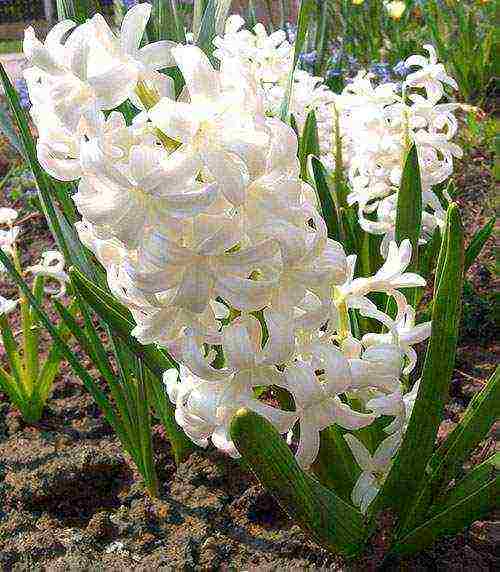 A competent choice of a place for planting hyacinths in open ground and caring for plants before and after flowering is the key to a long spring flowering.
A competent choice of a place for planting hyacinths in open ground and caring for plants before and after flowering is the key to a long spring flowering.
The area where hyacinths are to grow should be well lit, which in spring, when there is still little foliage, is easy to provide. But you will have to take care of protecting the flower garden from the wind.
Many gardeners make the mistake of planting bulbs under tree tops or near tall shrubs. On the one hand, such large vegetation will really save the inflorescences from the cold wind and will not shade until the foliage blooms. On the other hand, when it comes time to dig up hyacinths after flowering in the garden, the bulbs may not have enough nutrition to replenish their strength, which will affect their quality.
- Hyacinths prefer loose soil. It is better to mix clayey soil or black soil with peat or river sand.
- The growth of bulbs and the quality of flowering are positively influenced by the abundance of high-quality organic matter, but feeding with fresh manure can harm hyacinths.
- The acidity of the soil should not exceed 6.5 units, if the pH level is higher, lime flour is added to the soil.
Hyacinth bulbs react extremely poorly to waterlogging. If the groundwater at the site approaches the surface closer than half a meter, high ridges are arranged for planting hyacinths or powerful drainage is needed. To ensure the outflow of spring or rain moisture, a slight slope is sometimes made.
All preparatory work for planting hyacinths in the open field and caring for bulbs is best done at the end of summer. In a month or two, the soil will settle, and the autumn rooting of the bulbs will be faster and easier.
Planting hyacinths
 The soil under the hyacinths is dug 40 cm and at the same time the following is added per square meter:
The soil under the hyacinths is dug 40 cm and at the same time the following is added per square meter:
- 10-15 kg of well-rotted manure or humus;
- sand and peat, depending on the type and condition of the soil;
- 250 grams of limestone or 15 grams of magnesium sulfate;
- 200 grams of sifted wood ash or 30 grams of potassium sulfate;
- 60 to 80 grams of superphosphate.
If hyacinths are to be grown in the open field on sand, poor in minerals and organic matter, it is recommended to increase the amount of potassium and magnesium applied by one and a half times. The roots of the plant collect moisture and nutrition within a radius of 15–20 cm from the bulb. Therefore, the planting holes are made approximately of this size, deepening the bottom of the hyacinth by an average of 15 cm.
The finer the planting material, the higher the bulbs are embedded in the soil and the thicker they are in the flower bed.
In low-lying areas, hyacinths can be planted on a layer of sand, slightly pressing the bulb into it. This will protect the roots and the entire plant from rotting and possible infections. Flowering can be accelerated by planting bulbs on high ridges, which with the onset of spring will warm up much faster than a flat area.
Planting dates for hyacinths for growing in the open field
 In most regions of Russia, hyacinths can be planted in the ground from early September to mid-October.
In most regions of Russia, hyacinths can be planted in the ground from early September to mid-October.
- If the bulbs hit the ground earlier, or the fall is unusually warm, the plants start growing and die when frost sets in.
- If you are late with planting, the bulbs will not have time to root by the time the soil is frozen.
Nevertheless, it is possible to embed the bulbs in the soil in the first weeks of November. For this, the landing site must be covered with foliage or other suitable material in advance and covered with a film. The soil will keep warm, and the bulbs trapped in it will begin to grow as they should.
For the winter, it is better to shelter the planting sites of hyacinths from frost with the help of mulch from peat, sawdust, foliage or spruce branches. It will be necessary to remove the shelter in early spring so as not to damage the emerging sprouts.
Growing hyacinths outdoors and caring for them
 After planting hyacinths, outdoor care is reduced to regular feeding, loosening the soil, weeding and watering, especially during a set of buds and flowering.
After planting hyacinths, outdoor care is reduced to regular feeding, loosening the soil, weeding and watering, especially during a set of buds and flowering.
- Immediately after the emergence of sprouts, hyacinths need the first feeding at the rate of 30 grams of ammonium nitrate per square meter.
- The second fertilization occurs during the period of blooming of the buds. In this case, not only 20 grams of ammonium nitrate per meter is applied under the hyacinths, but also 30 grams of potassium chloride and 40 grams of superphosphate.
- When flowering is over, the plantation is fertilized at the rate of 40 grams of superphosphate and the same amount of potassium chloride per square meter.
All top dressing is applied to the aisles or the space between plants, covering 10 cm, and then the plantation is watered. Yes, and caring for hyacinths after flowering in the garden also begins with watering, which is extremely necessary in the first two weeks after the flower stalks dry.
Hyacinth care after flowering and harvesting bulbs
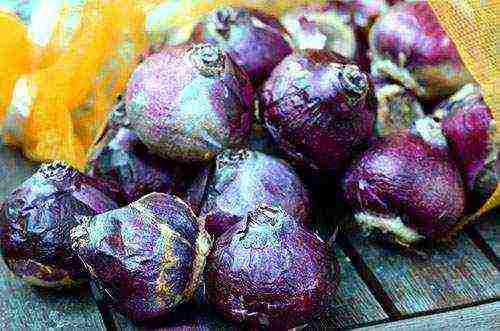 The bloom of hyacinths is magnificent, but fleeting. After drying the peduncles, the plant quickly loses its decorative effect. When the hyacinths have faded, what to do next in the garden? First of all, especially if the plantings of spring bulbs are combined with some other ornamental crops, the location of hyacinths should be noted. After all, soon, when the leaves droop, it will be extremely difficult to find them. Then, plants that recuperate after flowering need high-quality watering and feeding.
The bloom of hyacinths is magnificent, but fleeting. After drying the peduncles, the plant quickly loses its decorative effect. When the hyacinths have faded, what to do next in the garden? First of all, especially if the plantings of spring bulbs are combined with some other ornamental crops, the location of hyacinths should be noted. After all, soon, when the leaves droop, it will be extremely difficult to find them. Then, plants that recuperate after flowering need high-quality watering and feeding.
If in a Mediterranean climate the bulbs tolerate winter well and again delight with bright arrows of inflorescences, then in the middle zone of heat during the dormant period, hyacinths are clearly lacking. So, do you need to dig up hyacinths every year? Yes, it is precisely such a measure in the middle lane that will help create the necessary conditions for the bulbs for the formation and development of the bud of compensation and the rudiments of the future flower arrow.
If healthy bulbs of hyacinths in a temperate climate, without digging for the summer, are left for wintering in the ground, their flowering next year will be much weaker than before. Only gardeners in the Kuban, North Caucasus, Crimea and the south of the Black Earth Region can not burden themselves with the annual digging of bulbs, and then only with a fairly hot summer. When to dig up hyacinths after flowering in the garden?
The best time to harvest the bulbs is in the last decade of June or early July. By this time, the leaves turn noticeably yellow and weaken at the base, now they will be easy to remove.
Storing hyacinth bulbs
 When the bulbs are free of soil, rinsed and dried:
When the bulbs are free of soil, rinsed and dried:
- they are examined, separating diseased or damaged specimens during excavation;
- separate children requiring rearing;
- planting material is treated with pests and diseases for bulbs.
Then, for a week, the bulbs are kept at a temperature of about + 18–20 ° C in a ventilated room and placed in paper bags or containers in 1–2 layers.
Caring for hyacinths after flowering in the garden and storing the bulbs turns out to be the most serious undertaking for the grower.
During this time, the covering scales of the hyacinths dry up, the plant acclimates and is ready for the next stage of storage, when for two months the bulbs must be at a temperature of about + 30 ° C, sufficiently high humidity and good ventilation. A month before planting, the air temperature is lowered to +17 ° C, so that the planting material can more easily transfer the upcoming planting of hyacinths into the open ground.
Planting hyacinth in a flower bed - video
Many summer residents strive to grow hyacinths in their area, planting and caring for which in the open field require a certain amount of time. In this article, we will look at how to grow these beautiful flowers (even in those regions where the ground freezes in winter), when to dig up hyacinths, how to store bulbs, how to propagate your favorite variety.
 Hyacinths in a flowerbed (photo by Nadezhda Abramovich, Krasnodar)
Hyacinths in a flowerbed (photo by Nadezhda Abramovich, Krasnodar)
In early spring, as soon as the snow melts, green arrows of hyacinths sprout from the ground. This flower with a charming and pronounced aroma differs in all shades of the rainbow. Inflorescences in the form of tassels can be either regular or terry in structure; there are usually 20-30 buds on the peduncle.
↑ to the content ↑ Planting hyacinths in the ground - the choice of bulbs and places for planting them
Perennial hyacinth is a bulbous crop, the size of the bulb may vary depending on the type of flower. Planting material is considered an adult by the age of 5-6, when it is fully formed.The tuber is a scaly sphere with a bud of renewal - it is this that affects its growth. By the 5th year, adult bulbs usually acquire babies, which are formed near the bottom and are hidden under the scales.
Hyacinth, photo of flowers:
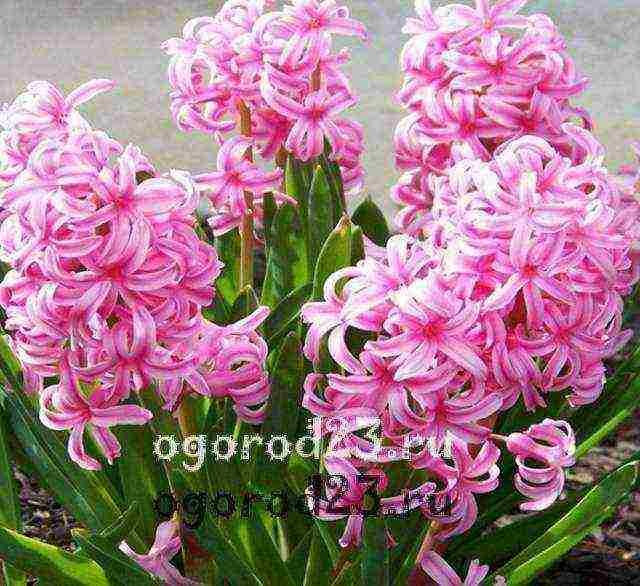
When choosing tubers, you should pay attention to the following nuances:
- Terry bulbs are often smaller than their regular bulbs.
- To grow flowers outdoors, the tuber must have at least 4 cm in diameter, a full-fledged active bud and multiple scales. Elasticity and heaviness are indicators of the healthy state of the bulb.
- The appearance of the bulb should be perfect - no damage, loose sides, mold.
- On the lower part of the tuber (near the bottom), root primordia should be present.
- The bottom of a suitable bulb for planting should be about one and a half to two times smaller than the bulb itself (we are talking about volume).
The key to a long and lush flowering is not only high-quality planting material, but also the planting site itself. You can set up a flower garden near trees or bushes, but not very close to them. The place for plants should be calm, well lit by the sun's rays. The soil is needed loose, if your site is dominated by black soil or loam, then it is advisable to add peat to it in advance (sand is also possible). Sod land or deciduous humus are excellent conditions for the development, growth and flowering of hyacinths.
As a fertilizer, organic matter gives good results, but you should not use manure. If the soil is acidic (pH above 6.5), then it should be diluted with dolomite (limestone) flour. Hyacinth tubers do not like excessive moisture very much. If on your site groundwater runs close to the surface (closer than 0.5 m), you cannot do without arranging high beds. In addition, the plants will have to provide a high-quality drainage substrate, as well as make a slight slope of the ridge - for better outflow of water during rains, spring melting of snow. With the arrival of spring, high beds are warmed up faster by the sun's rays, hyacinths bloom much earlier.
↑ to the content ↑ Growing hyacinths in the open field
It is highly desirable to prepare the soil in advance - to dig it to a depth of about 40-45 cm and add the required additives (depending on the composition and condition of the soil). Limestone (200 g), wood ash (150 g), superphosphate (50-70 g), magnesium sulfate (10 g) or potassium (20 g) are added at an approximate rate of 1 m² of land. So that fragile young roots are not damaged during planting, digging up the soil in the place of the future flower garden is also important. During the deepening of the bulbs, the soil temperature should be approximately 8-11 degrees, the distance between the tubers should be no more than 10-15 cm.If the flowers are planted in the beds, then the row spacing should be approximately 18-22 cm.If you want different varieties of hyacinths bloomed at the same time, make sure that all tubers are approximately the same in size.
Hyacinth, photo of bulbs:
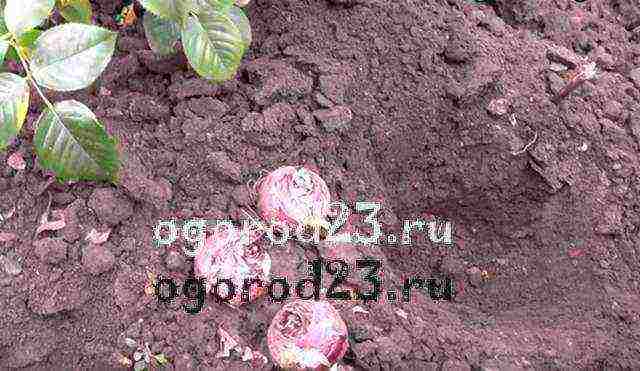
A good time to plant bulbs is mid September / October. It should be borne in mind that if you plant a tuber too early, then it will begin to develop, but it will not survive the winter. If you plant hyacinths too late, then they will not have time to take root and get used to the place - accordingly, they will also die. If you are late with planting, then hurry up by the first week of November - this is the latest date. To do this, you will have to resort to additional measures.
The place for the future flower garden is mulched with leaves or some other suitable material, covered with plastic wrap to keep warm. After the tubers are buried, the site is sprinkled with sawdust or peat, and it can also be covered again with foliage or coniferous spruce branches. A special covering material is excellent for this purpose.With the arrival of the first days of spring, the protective covering can be removed to make way for the emerging hyacinth sprouts.
As mentioned above, the bulbs should be healthy, but if you are still afraid of fungal manifestations, you can first soak them in a fungicide solution. The width and depth of the hole for the tuber should be equal to two of its sizes - about 15-25 cm, you can pour a little sand on the bottom, and then bury the tuber with the bottom down (about 13-15 cm). Sprinkle the bulb with soil, which needs to be tamped lightly, then watered. The root system of the plant absorbs moisture and nutrients from the ground within a radius of about 20 cm from the tuber - this should be taken into account. Small onions should not be deeply buried; they should also be planted quite thickly.
↑ back to content ↑ How to care for hyacinth
After the protective cover is removed, caring for the plants will consist in weeding, regular watering, loosening the soil, and applying top dressing. It should be borne in mind that hyacinths are bad for the neighborhood of weeds. When buds begin to set and flowering time comes, fertilizing the soil becomes especially relevant. After sprouting, the flowers can be fed with saltpeter (25-30 g per 1 m²).
The second stage of fertilization follows during the period when the buds are gaining color. Now, in addition to ammonium nitrate, you can add potassium chloride (25 g) and a phosphorus additive (for example, superphosphate, 35 g). At the end of flowering, superphosphate and potassium chloride are applied to the site - 35 g of each product per 1 m² of the area. The aisles or spaces between flowers are treated with fertilizers; after top dressing, watering always follows.
Hyacinths - how to care after flowering? Unfortunately, this wonderful period is fleeting; after the flowers dry, the roots should be saturated with moisture. For tubers to recover well after flowering, watering and fertilization should be in the first place. If you live in a "cold" region, then you cannot leave hyacinths for the winter, they will have to be dug out - these are necessary measures for the further favorable formation of replacement buds.
If you live in the Kuban, in the Crimea, in the north of the Caucasus, then the annual digging of tubers can be avoided, but only under the condition of a very hot summer. It should be borne in mind that the bulbs left in the ground will give much fewer flowers next year.
From my experience, I can share this observation: I accidentally dug up several hyacinth bulbs, forgetting that they grew in my place. I didn’t begin to dig in, as it was urgently necessary to plant a rose seedling. And I forgot about them, leaving them lying on the porch. Accidentally stumbled upon them only in the fall. Planted. And in the spring I was surprised by the large peduncles, abundantly dotted with flowers, which crawled out of the ground in this very place. Other hyacinths bloomed too, but their blooms were much more modest, something like the one in the photo below.
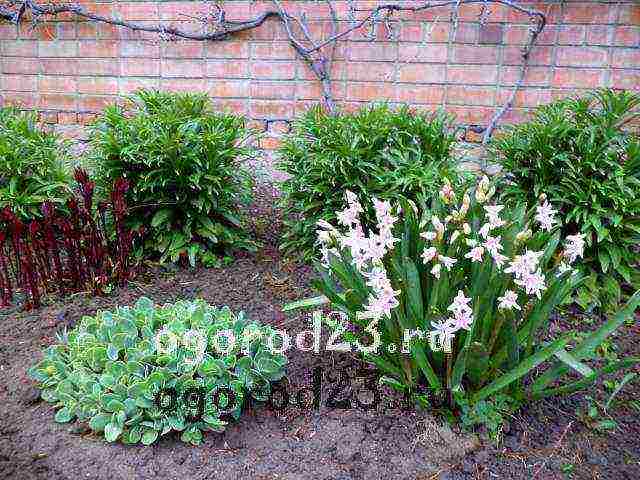 Hyacinths have not been transplanted for a long time (photo by Anna Nepetrovskaya, Novokubansk, Krasnodar Territory) ↑ back to content ↑ When to dig out hyacinths after flowering
Hyacinths have not been transplanted for a long time (photo by Anna Nepetrovskaya, Novokubansk, Krasnodar Territory) ↑ back to content ↑ When to dig out hyacinths after flowering
The optimal period is the last weeks of June - the first half of July, when the leaves of the plant turn yellow and weak. The ground part of the flower is removed, the tubers are removed from the soil, washed with water and thoroughly dried. Then we carry out an audit - we throw away the damaged (or with obvious signs of illness) specimens. If there are undeveloped babies on the bulb, they are separated and put aside for growing. Before storage, all tubers are subject to treatment against diseases and pests.
Planting material, photo:

After all the manipulations, the bulbs should be aged for about 7-10 days in a well-ventilated place at an air temperature of +17 .. + 20 ° C. To do this, they need to be laid out on clean paper, and after the specified time has expired, they must be hidden in paper bags. It is the period after flowering, as well as the processing and storage time of tubers, that are most important for hyacinths.At this time, the acclimatization of the planting material occurs, the scales dry up, the tubers are prepared for the summer period.
At a sufficiently high summer temperature, air access and moderate humidity should be provided to the bulbs (if the thermometer reaches + 30 ° C). About three weeks before planting, the temperature in the room with the bulbs should be lowered to + 16 ° C to help them adapt before planting.
↑ back to content ↑ How to propagate hyacinths at home
Separately, it is worth considering the methods of reproduction, since the tubers can give flowers for two or three years, but at the same time they will not form children. For this, the bulbs need stimulation, it is carried out in various ways.
↑ to the content ↑ Cutting the bottom of the hyacinth tuber
Even during planting, the place where the largest bulbs are planted is determined on the site. After the leaves of the plant turn yellow, the tuber is removed from the ground and immediately, without letting dry, arrange a "shower" under the strong pressure of water. During this process, old scales are removed along with the soil. Next, the bulbs are laid out in one layers in a ventilated box, taken out to a shaded place, dried for about 7-10 days. After this time, using a sharp knife, a wedge-shaped cut is made on the bottom, in which the kidney and the bottom itself are completely removed. The cut site must be treated with crushed activated carbon.
After this operation, the tubers are laid out in a container, the bottom of which is covered with a layer of perlite. The bulbs should be placed with the cut bottoms up. Next, the container is placed in a large plastic bag (you can use garbage bags) to create the required microclimate. At a temperature of + 30 ° C and high humidity, babies will appear at the cut site, and after 2-3 months they will reach about 1 cm, acquire root rudiments and sprout small processes. If the bottom was cut out in the first months of summer, then the tuber with children can be planted in the soil and covered with sawdust (or peat).
If time is missed, then the tubers are turned upside down, placed in a container with soil, placed in the cold (refrigerator, basement), and with the onset of spring they are planted on the site.
After the hyacinths have faded, what to do with them? With the onset of August, these tubers are dug up (by that time they are already covered with children), the children are separated. By early September, the young generation of hyacinths is buried in the soil, covered with a 10 cm layer of mulch (sawdust, spruce branches, foliage, peat). At the end of the first wintering, the mulching layer is removed, but left in place after the second winter. In the third year, these hyacinths give color and delight you with a wonderful aroma.
↑ to contents ↑ Reproduction by scales from bulbs
Large tubers (about 5-6 cm in diameter) are cut into 4 parts, after which some scales are separated from the bottom, the "wound" surface is treated with crushed activated carbon. Next, a container is taken, at the bottom of which perlite or clean sand is poured; you can also use crushed charcoal with ash. Broken flakes are placed in this container, then it is placed in a transparent plastic bag, tied securely and kept for 2 months in not too bright light.
At the same time, the air temperature should be approximately + 19..23 ° С, but at the second stage, which lasts a month and a half, the temperature should be reduced to + 16..19 ° С. During this period, several bulbs will be tied on the scales. Young stock storage is similar to the method described in the first method.
↑ to the content ↑ Propagation of hyacinths by cuttings of a leaf
To do this, you should wait for the period of the ovary of the peduncles and separate from the hyacinths by a couple of leaves, they must be cut as close to the base as possible. Then the leaves are treated in a solution that stimulates root formation (for example, "Heteroauxin") and buried 3-4 cm in a container with clean sand (or perlite).This container, again, is enclosed in a plastic bag, tied up and placed in a moderately lit place for a month and a half. The air temperature should vary within + 10..17 ° С, humidity - 80-90%. After the specified period, you can see bulbous buds on the cuttings, and after 50-60 days - young roots and small leaves. Further, the plants are planted on the site, each stalk subsequently gives 6-10 children.
↑ to the content ↑ Notching the bottom, as a way of reproduction of hyacinth
In this procedure, the end is not removed, as in the first case, but is cut crosswise. A couple of crosses are made on large tubers, on those that are smaller - one. The damaged areas are treated with powdered activated carbon, then the bulbs are placed in a warm room for 24 hours (+ 20..22 ° C) so that the “crosses” open up. All further actions are similar to the above recommendations. With this method of stimulating the tuber, it is possible to obtain about 10-16 large young bulbs.
For these messengers of spring to delight you with long flowering, the splendor of the tassels and an amazing aroma, you need to make an effort. Now you know how to grow hyacinths, planting and caring for them in the open field, although they are fraught with difficulties, are undoubtedly worth the effort and time.
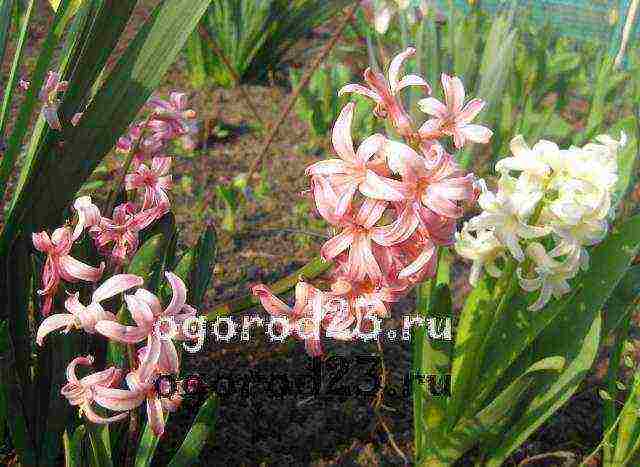
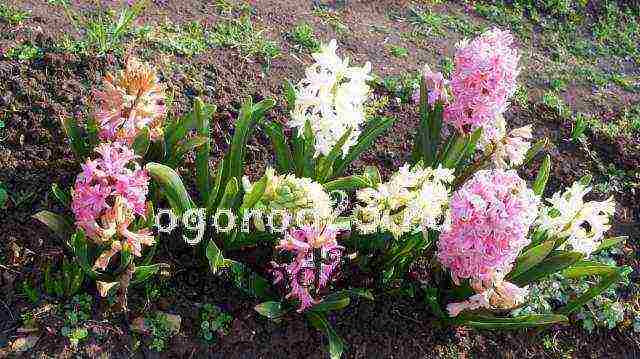 First flowers (photo by Lyubov Belykh, Krasnodar)
First flowers (photo by Lyubov Belykh, Krasnodar)
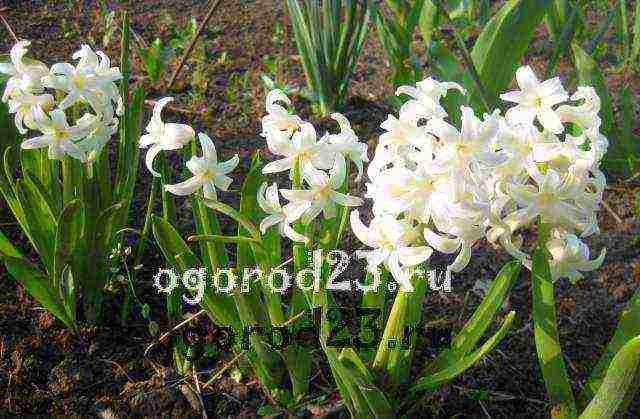
Charming hyacinths are early flowering bulbous with incredibly beautiful and fragrant racemose inflorescences. Each tassel of the plant resembles a small cylinder and consists of many small bell-shaped-funnel-shaped flowers with slightly bent petals.
Depending on the variety, hyacinth reaches a height of 22-28 cm, and usually blooms from late April to early June, on average, 7-18 days per flower. The first to please you with their splendor are blue and blue hyacinths, then pink and white varieties will come into play, followed by lilac, purple and red, and with a slight delay, the flora of yellow and orange colors will play.
Planting hyacinths
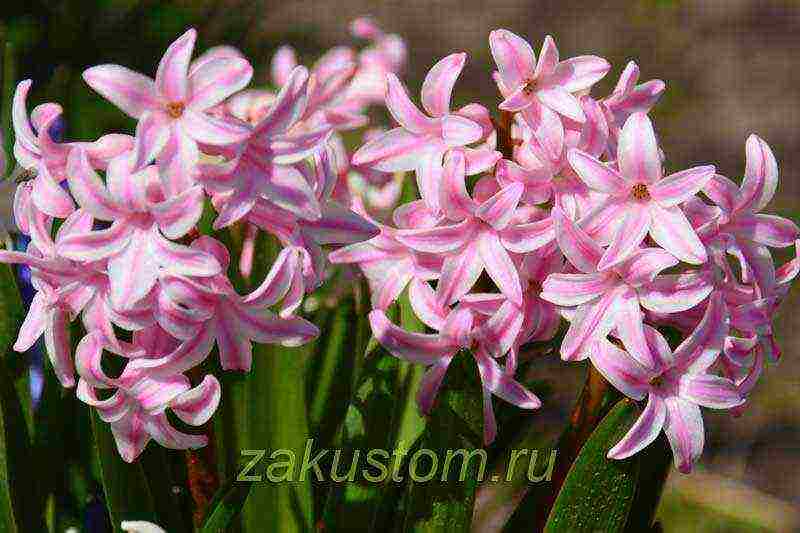
Landing space
Hyacinths prefer calm and normally lit areas, preferably without direct sunlight. An openwork partial shade is well suited for them. After flowering, in the dormant stage, plants can be in the shade.
In the near-trunk circles of trees and shrubs, it is better to plant hyacinths at some distance, since these flowers do not like to compete for nutrients.
Also, hyacinths do not like waterlogging - they are not suitable for areas where runoffs accumulate, as well as places where groundwater is close (above 60 cm). If necessary, drain well and level the area. It is optimal to plant hyacinths on a small hill, slope, or make raised flower beds.
Another important point is that it is undesirable to plant hyacinths after bulbous, as well as after root crops.
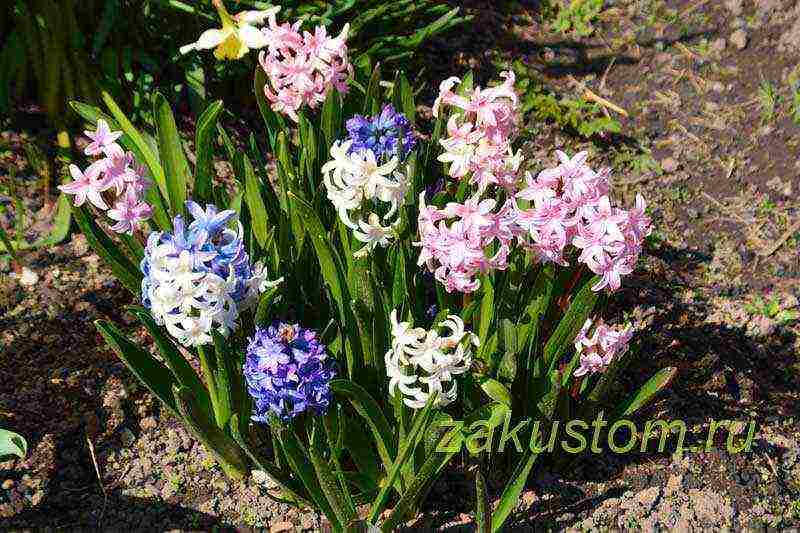
The soil
Hyacinths like fertile, well-drained and light soil with a neutral reaction, such as loose and organic-flavored loam or sandy loam. A substrate of sand, sod and fertile land in equal proportions, with an addition of minerals, is also suitable.
If the soil is "acidic", it must be neutralized six months before planting by adding dolomite, lime or chalk. Coarse sand should be mixed into dense clay soil. Be sure to dilute depleted or poor podzolic soil with rotted humus.
Landing dates
Hyacinths are planted in open ground in the fall, usually from the end of September to the third decade of October. The optimum soil temperature for planting hyacinth bulbs is + 7 ... + 10C.
On the one hand, planting should not be delayed, since the plant should root normally before the cold weather. And, conversely, planting too early will lead to the fact that hyacinths will germinate inappropriately, and will bloom poorly next year.
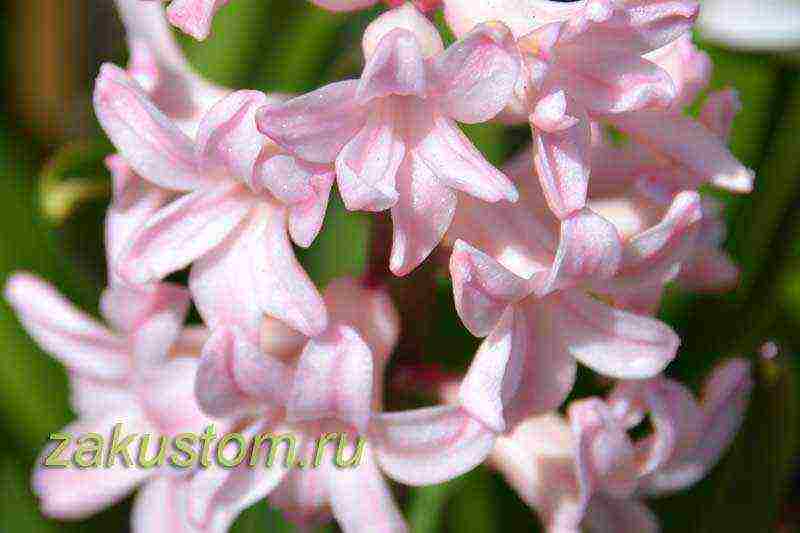
If the deadlines are delayed, the site should be insulated ahead of time with leaves or other material, and immediately after planting, cover everything with foil.
See the auspicious day for landing according to the lunar calendar.
Preparing the bulbs
For planting, pick up the so-called. flower bed bulbs of hyacinths are medium in size, within 4-6 cm, although for terry varieties the bulbs may be smaller.
Go through the planting material: it should be dense, not wrinkled, without spots, rot or other signs of disease. The diameter of the "equator" of the bulb should exceed the diameter of the bottom by 1.5-1.6 times.
Before planting, hold the hyacinth bulbs for half an hour in potassium permanganate (3-5 g / bucket), in 0.2% Fundazole essence or in the Hom preparation (40 g / bucket), then dry.
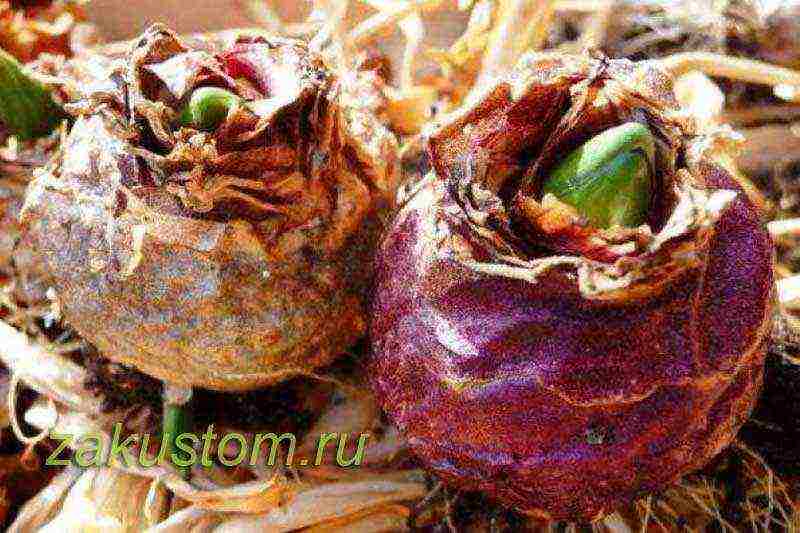
Hyacinth bulbs
Soil preparation
No later than 2 weeks before planting, dig up the ground 35 cm, at the same time removing all weeds, level the area or make a raised flower bed.
Under the digging, add, per sq. m:
- rotted manure or old compost, 10-15 kg;
- mineral fertilizers: 55-60 g of superphosphate, 12-15 g of magnesium sulfate, up to 30 g of potassium sulfate. On impoverished soils, it is advisable to increase the dose of potassium and magnesium by 1.5 r.
Landing
The depth of laying of these cute plants is equal to three times the height of the onions, usually 12-18 cm from the bottom.... Smaller onions can be planted shallower.
In the prepared area, make holes and pour a hill of clean sand up to 5 cm on the bottom.Place the bulbs on a substrate and lightly press into the sand. Then first sprinkle the hyacinth bulbs with the same sand, and then add the earth on top. The sand cushion improves drainage and prevents the bulb from rotting.
The standard distance between flowers in a line is 12-15 cm, between rows - 20-25 cm.
If the soil is dry after planting, it should be watered. And, conversely, when a rainy autumn stood out, it is recommended to cover the ridge with a film to protect it from waterlogging.
Care
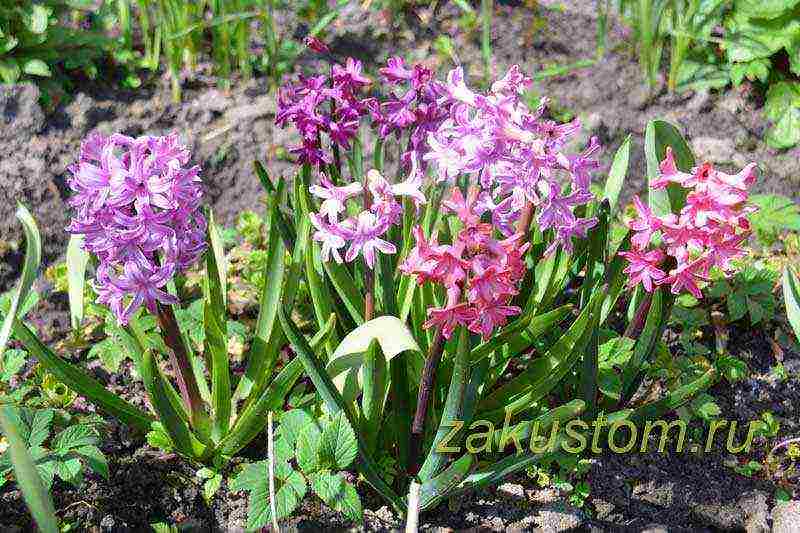
Watering
Hyacinth is a drought tolerant plant, its watering depends on the weather. Nevertheless, in the early stages of development, the soil under it should not dry out. On warm spring days, if the ground is dry, the hyacinths should be watered moderately so that the flowerbed is saturated by 15-20 cm.In the flowering phase and a couple of weeks after it, if there is no rain, water them more actively, and limit the moisture at the dormant stage.
Loosening, weeding
The top should be loosened regularly to allow air to reach the roots. This is best done after watering or rain. Remove weeds while weeding.
Top dressing
Under the hyacinths, root dressing is applied several times per season in the form of granules embedded in the soil or in the form of a solution, per sq. m:
- in the phase of active growth, 20-25 g of ammonium nitrate and up to 20 g of superphosphate;
- when tying buds, 30 g of superphosphate and 15 g of potassium sulfate;
- after flowering, 40 g each of potassium sulfate and superphosphate.
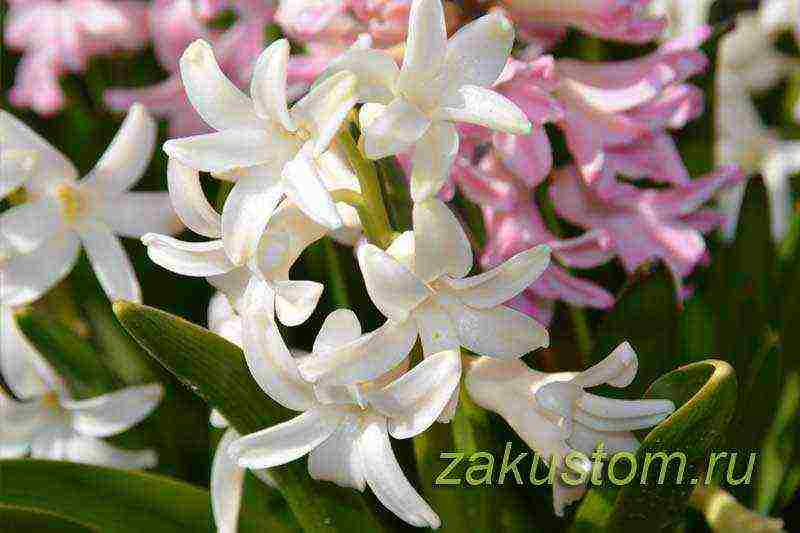
Wintering
When the soil is already slightly freezing, mulch the planting site 5 cm with dry peat, humus or sawdust. And after the temperature drops below zero, additionally insulate the flower bed with dry leaves, spruce branches by 15-20 cm or cover with lutrasil. In the spring, carefully remove the shelter so as not to damage the hatched sprouts.
Disease prevention
Do not use diseased onions; remove spotty, broken, dry twigs and peduncles in time; do not add fresh manure to the soil; properly store and always disinfect the planting material; Do not plant densely, after bulbous predecessors, in a humid place, on acidic soil, or very early.
- Plant with bacteriosis (yellow, white rot) it is better to remove completely, burn the bulbs, treat the hole with bleach or 5% formalin, transplant the flowers, the bulbs can be treated with a 15% solution of vitriol.
- For the prevention of fusarium (fungus) in the growing season, flowers are sprayed with flowers with foundation or topsin.
- Against ticks and a bear helps the shedding of earth with diazin, basudin or colloidal sulfur.
- Against the fly - drugs "Tabazol", "Aktara".
- Against aphids - karbofoska or Aktellik.
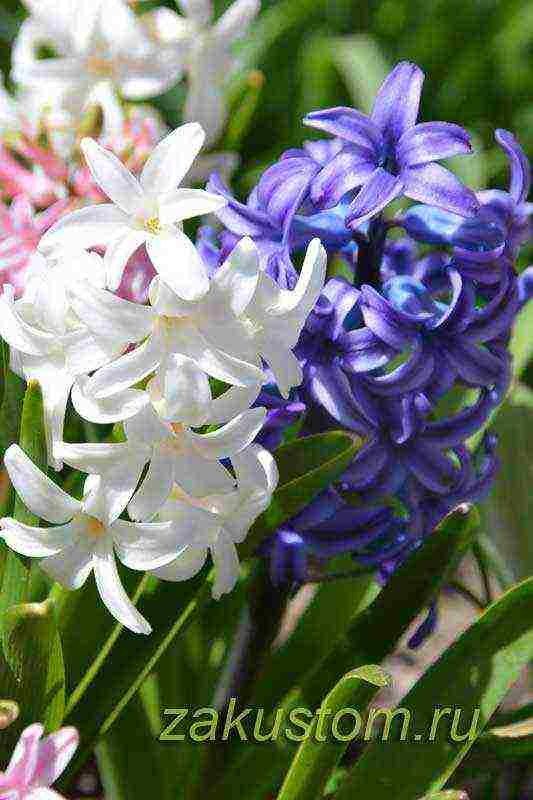
Reproduction and storage of bulbs
Each "mother" forms 3-4 "daughters" in a year. Dig up last year's tuber after flowering, at the end of June - in July, when the leaves have dried and turned yellow. Separate the daughters, dry the bulbs, ventilate them in the shade, sort and store in a cardboard box with sand or newspapers. It is better to store them, starting from t + 26 ... + 29С for the first 2 weeks, gradually decreasing by 5-7С every couple of weeks until planting, but no more than + 16 ... + 17С. And in the fall, the onions can be planted (the roots of the hyacinth begin to swell, it seems to "prompt" the planting date).
Hyacinths should not linger in one area. Transplant these flowers to another flower bed every 3-4 years to reduce the risk of disease.
After flowering, cut off adult plants that are not planned to be transplanted, leaving green leaves to the maximum until they die off on their own, and cover for the winter in the fall.
Hyacinths in landscape design
Hyacinths look elegant and organic in rockeries, on a convex flower bed or in symmetrical areas, on an ordinary flower garden, as well as along a garden path or against a background of trees and shrubs. Thanks to hyacinths, you can create the most incredible flower patterns.
At the same time, try to keep the palette not too variegated. For example, monochrome hyacinth plantings look very gentle, noble and cute.
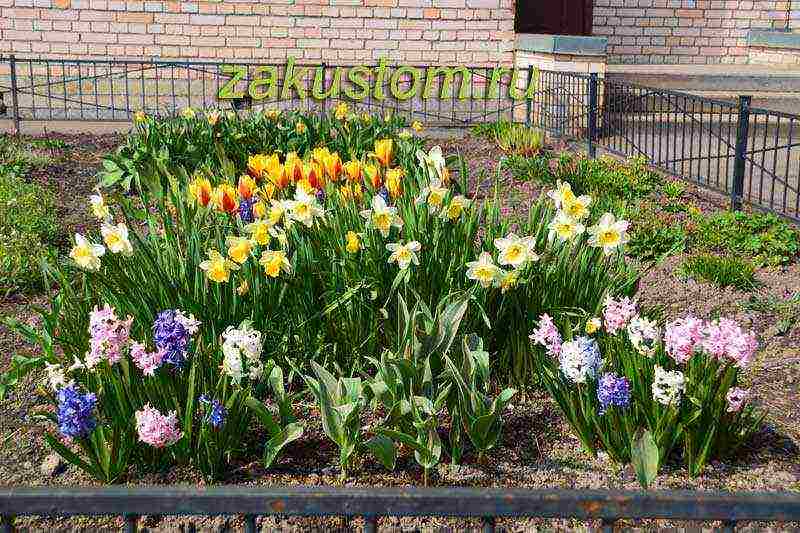
Flower bed of bulbous - tulips, daffodils, hyacinths
Hyacinths bloom early, so in group plantings they are best combined with other bulbs. Mixed glades of hyacinths, daffodils and tulips look especially picturesque. Blue and lilac hyacinths combine fabulously beautifully and elegantly with white tulips or yellow daffodils, and orange-toned hyacinths are beautifully set off by bright red tulips.
After flowering, hyacinths leave empty spaces in the flower bed, so it is appropriate to plant various perennials with lush foliage there, or such annuals as petunias or marigolds, which will hide the voids.
In addition to open ground, hyacinths are also successfully grown as a houseplant in flowerpots, baskets and pots, exposing them to windowsills, porches or balconies.
When properly planted and cared for, beautiful and delicate hyacinths will wonderfully decorate your garden or your favorite flower bed, delighting with the delicate aroma and youthful purity of spring primrose.

"Flower of sorrow" - this is how the ancient Greeks called hyacinth, modern florists consider it a flower of "love and fidelity". All this is about him - about fragrant hyacinth. Today modern florists are sharing their experience on how to grow hyacinths in open ground, flowerpots and even on the windowsills of small apartments.
Growing hyacinths outdoors
An incredible, intoxicating smell, a variety of shades of inflorescences, ease of care and a relatively long flowering period, in relation to an affordable price, makes hyacinth flowers a feminine favorite. Planting and caring for lovely buds in the garden is one of the most enjoyable jobs of amateur flower growers.
Millions of pots of hyacinths are sold throughout the country for the favorite spring women's holiday and not only. Having delighted the owner for some time, giving her all its color and aroma, the hyacinth withers, leaving a small onion in memory of itself. And, of course, you should not throw away the faded plant. It is much more prudent to prepare and transplant the bulb into open ground. And again and again enjoy its unique spring bloom. Moreover, hyacinth is one of the favorite early folk primroses.
What land is needed for hyacinth
Before starting planting, it is important to choose the right soil. The most suitable for a bulbous plant will be loose soil that allows water to pass through with ease.The ideal option will be obtained if such land is additionally enriched with mineral fertilizers. For this, both a purchased packaged product and ordinary humus are suitable, which is introduced into the soil to a depth of 30 to 40 cm.The only thing you need to pay attention to in this case is that the soil for hyacinths with the help of mineral fertilizers should be prepared in advance, ideally , a couple of months before planting.
Does hyacinth love sun or shade?
An unpretentious plant can be grown both in areas open to sunlight and in slightly shaded places. Do not plant bulbs under bushes or close to trees, the root system of the latter can drown out the growth of flowers. The most important thing is to protect the bulbous plants from drafts and constant gusts of wind. It is worth paying attention to the possibility of water stagnation at the landing site. Like any bulbous plants, hyacinth does not like excess moisture; a constantly wet bulb can simply rot. Therefore, if in doubt, it is better to plant flowers on a small hill or on a slope, in which case the water will definitely seep below the planting level and heavy rainfall will not harm them.
When to plant hyacinths in the ground
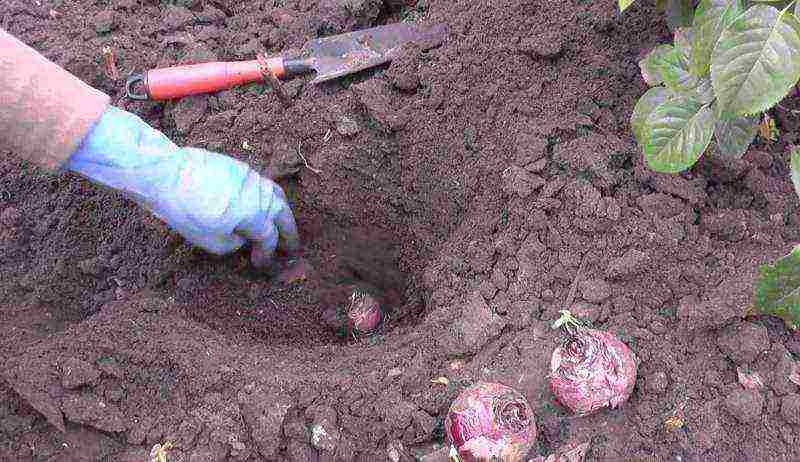
Having learned in advance how to plant hyacinth in the ground, you can avoid the typical mistakes of novice gardeners. So, the main directions in landing:
- soil preparation begins 2 months before planting, that is, in the month of August; the earth is fertilized with minerals, bend, loosening from time to time;
- planting time and how to plant hyacinths in the fall in open ground - in September - early October (before the soil freezes), they begin directly planting the bulbs. If you start planting ahead of time, the bulb will grow and simply ... freeze. The flowering period of hyacinths in the open field: April - March, they will not be able to hatch through a snowdrift. So, having made a depression in the ground (15 cm will be enough) with a garden trowel, you can start planting. The flowers themselves must keep a distance of at least 20 cm between themselves in the flower bed;
- bulb care. The main thing to remember here after planting is to make sure that the bulbs do not freeze over the winter. Sawdust, fallen leaves, dry peat and other mulching materials, both organic and inorganic, will help prevent this.
Attention! If the soil has not been fertilized beforehand, it is recommended to sprinkle the bottom of the hole with sand mixed with peat or rotted compost.
Hyacinth care in the garden
When planting is complete, you can forget about the bulbs until they start growing. It was when a young bore appeared, and feeding and watering of the plant began. Ammonium nitrate and superphosphate are quite suitable for the first feeding. You can simply sprinkle the substances in the dose indicated on the package, and then, loosening the ground with a garden glanders, water the soil.
How to water hyacinths in the garden
After planting, the question may immediately arise: how often to water the hyacinth? At home, everything is clear: you just need to ensure that the soil does not dry out and water the pot from time to time to the top with settled water at room temperature. In the garden, rainfall regulates the process, frequency and temperature of water for irrigation. If there is no rain, it remains only to prevent the soil from completely drying out, especially during the flowering period, otherwise the bulb from a lack of moisture may simply throw off the inflorescences and the plant, which could please the eye for a long time, will go into hibernation until next year.
When the plant has already completely bloomed and only a bulb remains in the ground, it does not need to be specially watered at all, it should lie dormant before transplanting.
If it is decided to transfer one of the plants from the summer cottage to your favorite windowsill, it is better to first place the dug out onion in a glass of water.Of course, she should not swim there, it is worth picking up a glass by size, germination of hyacinth goes like sprouting ordinary onions at home. When a green bore appears, the flower can already be planted in a full-fledged pot with earth. Of course, it is better if it is specially selected purchased soil.
How to care for hyacinths in the garden
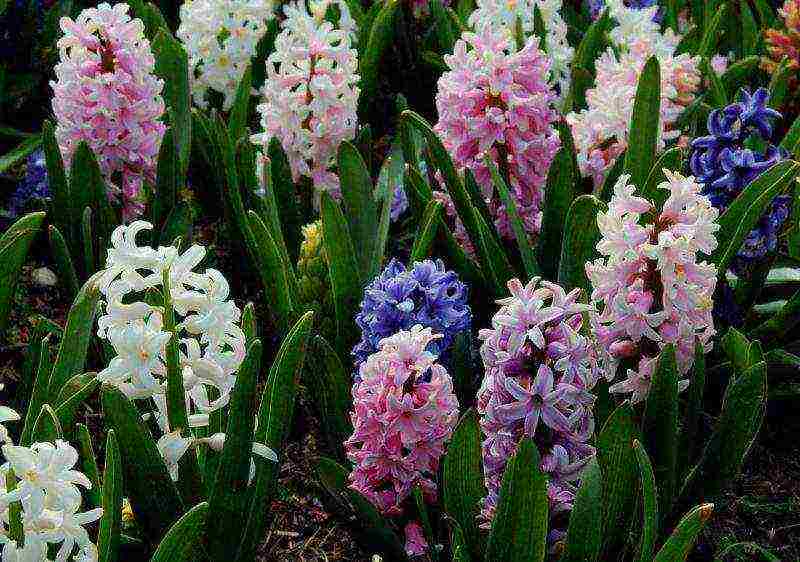
Do not forget about mineral fertilizers (superphosphate and potassium sulfate), which are best used at the beginning of the formation of hyacinth buds. This can be done both by sprinkling the substances (in dry form), and during irrigation, diluting in water. Already in the flowering period, so-called micronutrients, such as boric acid and zinc sulfate, for example, are suitable for feeding.
How to plant hyacinths in the spring in the garden
Despite the fact that hyacinth is considered to be a primrose, you can admire its delightful flowering even later. For this, the bulbs are planted in open ground in the spring. If this season is chosen for planting, then before starting the process, the flower bulbs are recommended to be placed in the refrigerator for an hour, or rather, in the freezer. Florists call this method of planting stratification. Thus, deceptive conditions for simulating "winter cold weather" are created. The main thing is to do everything wisely, do not freeze the bulb for too long, otherwise it will freeze and you can not wait for flowering. When to plant hyacinths in open ground in spring, common sense and forecasters with a meteorological forecast will tell you. The soil should be warmed by the sun's rays in the spring, and the threat of frost is also unacceptable.
Ammonium nitrate and potassium will serve as fertilizers for the soil during the spring planting period. Of course, they should be used on the ground after the snow has completely melted.
In order for the roots of the plant to breathe, it is recommended to loosen the soil after spring planting from time to time with garden tools.
When the beauties of the hyacinth have faded, its bulb will again require attention and care. During this period, the soil will again need to be treated with superphosphate and potassium sulfate. The faded flower itself can be cut off higher, allowing the plant to fade in a natural way. It is not recommended to leave the bulbs in the same place every year, the earth and the flower should rest from each other for 3 years. The thing is that the soil can accumulate pests and various pathogens, and the bulbous handsome man is quite sensitive to them.
All articles about hyacinths on the site can be read by following this link ...
For a year, each planted onion gives 3-4 shoots, therefore it is not difficult to breed beautiful spring primroses! With proper care, the bulb will delight again and again with flowering and aroma.
